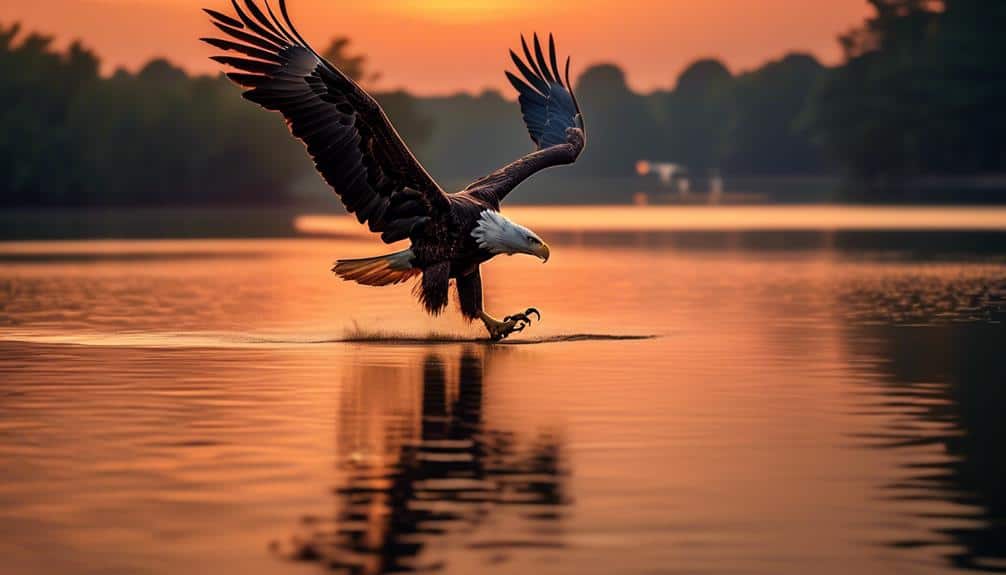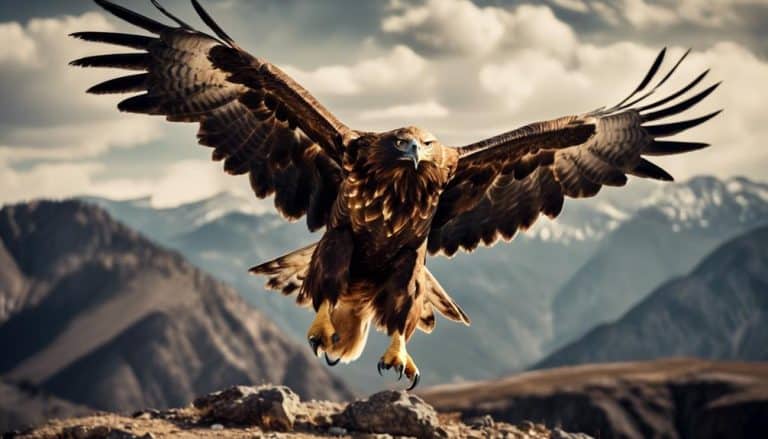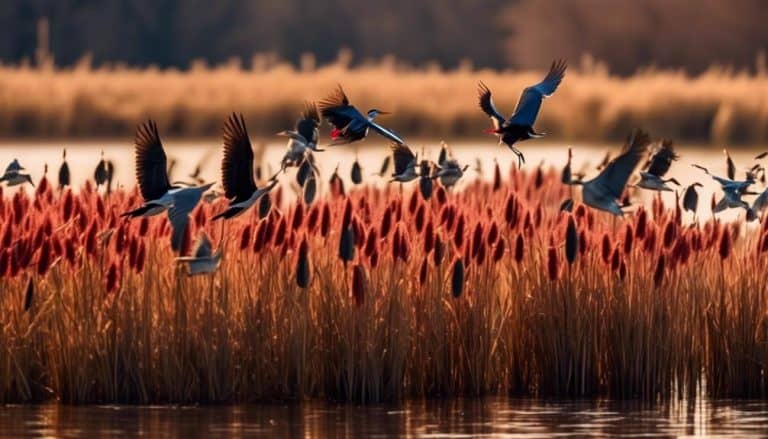So, apparently North Carolina has some truly massive feathered creatures roaming around. And by massive, I mean really, really big.
Now, I know what you're thinking – big birds? How fascinating could they possibly be? Well, let me tell you, my dear reader, there's more to these avian giants than meets the eye.
From the majestic kings of the skies to the elegant migratory birds in the wetlands, North Carolina is home to a diverse array of big birds that are sure to leave you in awe.
But I won't give it all away just yet. Stick with me, and you'll discover the breathtaking beauty and remarkable behavior of these magnificent creatures.
Bald Eagles: The Majestic Kings of the Skies

Bald eagles, with their regal presence and commanding flight, reign as the majestic kings of the skies in North Carolina. These magnificent birds have long been a symbol of power and resilience, and their conservation efforts have been instrumental in their population growth over the years.
Bald eagle conservation efforts in North Carolina have focused on protecting their habitats and ensuring their survival. The state has implemented strict regulations to safeguard their nesting sites and restrict human disturbance. Additionally, efforts have been made to monitor their population and track their movements, providing valuable data for conservation strategies.
As a result of these conservation efforts, the bald eagle population in North Carolina has experienced a significant growth. From just a handful of nesting pairs in the 1980s, the population has now soared to over 200 pairs. This remarkable increase is a testament to the success of conservation initiatives and the commitment to preserving these majestic creatures.
Observational studies have revealed fascinating insights into the behavior and habits of bald eagles in North Carolina. Their impressive hunting skills and incredible aerial displays showcase their dominance in the skies. Watching them soar effortlessly and dive with precision is a sight that never fails to inspire awe.
Great Blue Herons: Graceful Waders of Coastal Marshes
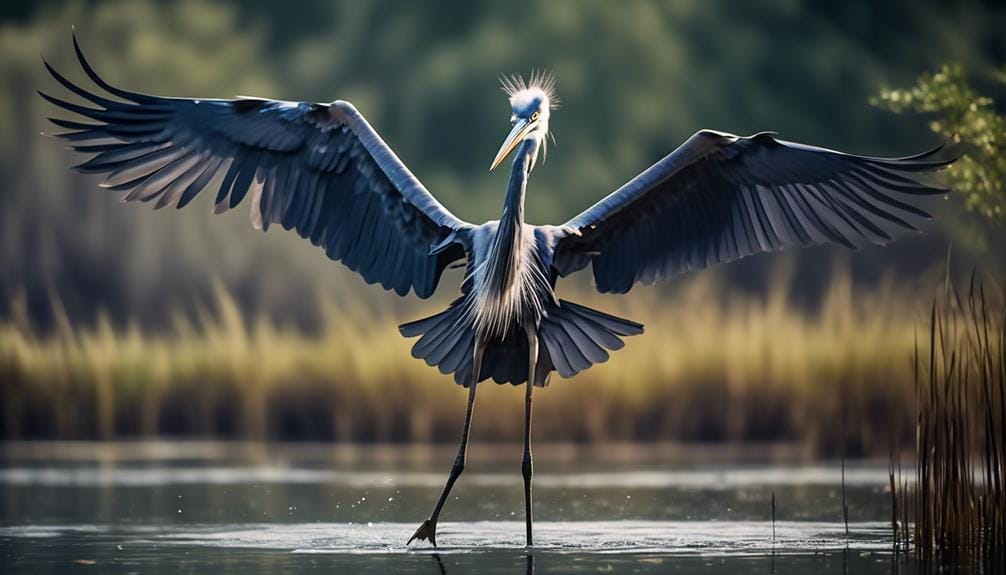
With their elegant stature and graceful movements, the Great Blue Herons emerge as captivating inhabitants of the coastal marshes in North Carolina. These majestic birds, standing at an impressive height of up to 4 feet, possess long necks and dagger-like bills perfectly adapted for their wading lifestyle. As I observe them in their natural habitat, I'm struck by their ability to blend seamlessly into the marshy surroundings, their slender bodies perfectly camouflaged among the reeds and grasses.
Here are some notable characteristics and behaviors of these graceful herons:
- Feeding Habits:
- The Great Blue Herons are skilled hunters, patiently waiting for their prey to pass by before striking with lightning-fast precision.
- Their diet mainly consists of fish, but they also opportunistically feed on amphibians, reptiles, and small mammals.
- With their sharp eyesight, they're able to detect movements beneath the water's surface, enabling them to catch their prey with incredible accuracy.
- Nesting Behavior:
- These herons are colonial nesters, often forming large breeding colonies in the coastal marshes.
- They construct large stick nests high up in the trees or on platforms, providing a safe haven for their offspring.
- The nests are intricately woven and can reach impressive sizes, sometimes measuring up to 4 feet in diameter.
- Courtship Rituals:
- During the breeding season, Great Blue Herons engage in elaborate courtship displays, which involve stretching their necks, pointing their beaks skyward, and engaging in synchronized dances.
- These displays serve to establish and strengthen pair bonds, ensuring successful breeding and raising of their young.
Red-tailed Hawks: Stealthy Hunters of the Appalachian Mountains
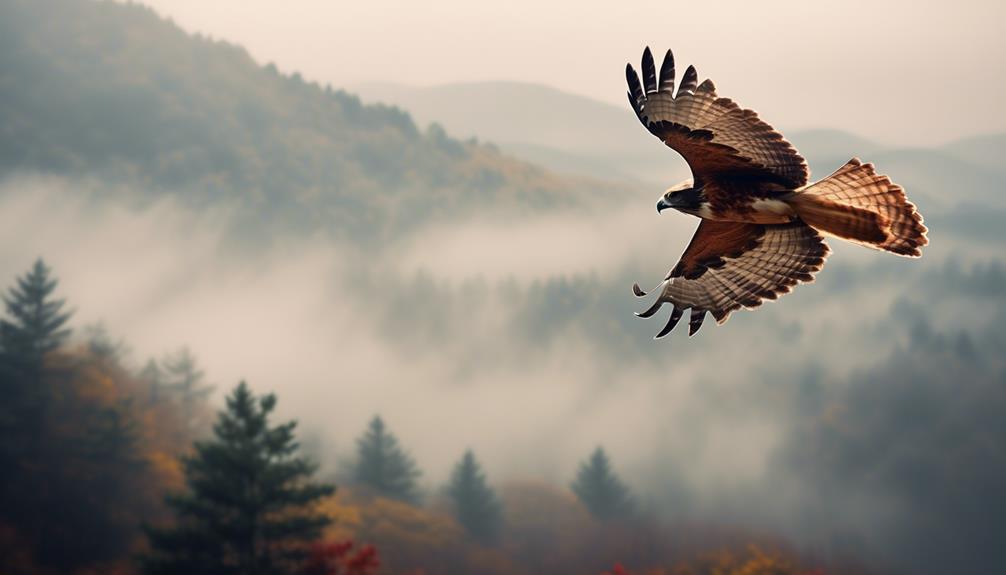
Red-tailed Hawks are formidable hunters that exhibit remarkable stealth and agility as they soar through the Appalachian Mountains. These majestic birds have adapted their hunting techniques to thrive in the diverse habitats found in this mountain range.
| Hunting Technique | Description | Advantage |
|---|---|---|
| Stoop | A rapid, steep dive towards prey | Increases velocity, ensuring a successful strike |
| Perch and Wait | Observing prey from a high vantage point | Saves energy and allows for strategic ambush |
| Soaring Hunt | Scanning the ground while soaring on updrafts | Covers large areas efficiently, maximizing hunting opportunities |
Red-tailed Hawks are known for their stealthy hunting techniques, utilizing the diverse Appalachian mountain habitats to their advantage. Their ability to stoop, or dive rapidly towards their prey, allows them to increase their velocity and ensure a successful strike. By perching and waiting, these hawks conserve energy while observing potential prey from a high vantage point. This strategy allows for strategic ambushes, catching their prey off guard. Additionally, Red-tailed Hawks take advantage of the updrafts created by the mountainous terrain to soar and scan the ground for potential meals. This soaring hunt technique allows them to cover large areas efficiently, maximizing their hunting opportunities.
In the Appalachian Mountains, Red-tailed Hawks have mastered the art of stealthy hunting. Their adaptability and agility make them highly successful predators in this challenging environment.
Sandhill Cranes: Elegant Migratory Birds in the Wetlands
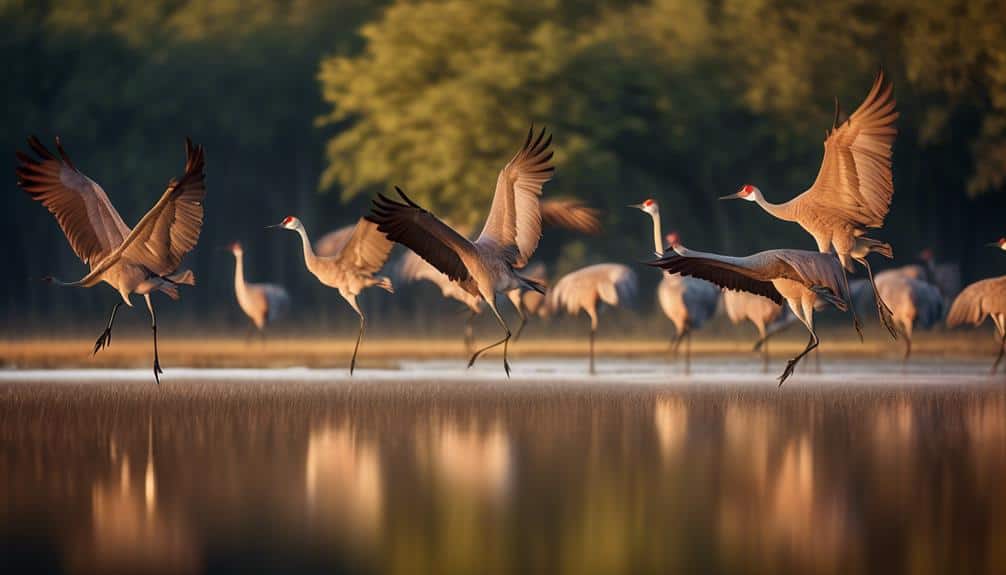
Sandhill Cranes, with their elegant stature and distinct migratory patterns, are a captivating presence in the wetlands. These majestic birds, standing at an impressive height of up to 4 feet, are known for their long necks, gray plumage, and vibrant red caps. As I observe their behavior in the wetlands, I'm struck by their synchronized movements and melodic calls that echo through the marshes.
Here are some key observations and facts about Sandhill Cranes in the wetlands:
- Wetland Conservation:
- Sandhill Cranes heavily depend on wetlands for nesting, foraging, and resting.
- The preservation and restoration of wetlands are crucial for maintaining the habitat of these magnificent birds.
- Wetland conservation efforts play a vital role in ensuring the survival of Sandhill Cranes and other wetland species.
- Bird Migration Patterns:
- Sandhill Cranes are renowned for their impressive long-distance migrations.
- They breed in the northern parts of the United States and Canada during the summer months.
- As winter approaches, they embark on a remarkable journey, flying thousands of miles to reach their wintering grounds in the southeastern United States.
- Importance of Wetlands in Bird Migration:
- Wetlands serve as vital stopover points for Sandhill Cranes during their migratory journeys.
- These wetlands provide abundant food resources and safe resting areas for the cranes to refuel before continuing their journey.
American White Pelicans: Impressive Flock Flyers of North Carolina

Nestled among the wetlands of North Carolina, the American White Pelicans take flight in impressive flocks, showcasing their remarkable aerial prowess. These majestic birds are known for their distinctive appearance, with their large size, long wingspan, and striking white plumage. As I observe them in their natural habitat, I can't help but be captivated by their fishing habits and breeding patterns.
When it comes to fishing, American White Pelicans employ a unique cooperative strategy. They gather in large groups and form a semi-circle in the water, herding fish towards shallower areas. With synchronized movements, they dip their bills into the water, capturing fish in their expandable pouches. This method allows them to catch a substantial amount of prey in a single feeding session.
Breeding among American White Pelicans occurs during the spring and summer months. They form breeding colonies on remote islands or secluded areas along the coast. Males engage in elaborate courtship displays, which involve head bobbing, wing flapping, and vocalizations. Once a pair has formed, they build a shallow nest on the ground using vegetation. The female typically lays two to three eggs, which both parents take turns incubating. After about a month, the chicks hatch and are cared for by their parents, who diligently provide them with regurgitated food.
Frequently Asked Questions
How Many Eggs Do Bald Eagles Lay at a Time?
Bald eagles typically lay 1-3 eggs at a time, with 2 being the most common. Bald eagle breeding behavior involves both parents participating in nest building and incubation, ensuring the eggs are protected and cared for.
What Is the Average Wingspan of a Great Blue Heron?
The average wingspan of a great blue heron is approximately 6 feet. These majestic birds can be found across North America, including in North Carolina. They are known for their impressive feeding habits and intricate nesting behavior.
How Fast Can Red-Tailed Hawks Fly?
Red-tailed hawks are impressive hunters, capable of reaching speeds up to 120 miles per hour. They use their keen eyesight to spot prey from high above, and their migration patterns cover vast distances.
What Is the Lifespan of a Sandhill Crane?
The lifespan of a sandhill crane can vary depending on several factors. These factors include habitat quality, predation, food availability, and disease. Understanding these factors is crucial for studying the long-term survival of sandhill crane populations.
How Far Do American White Pelicans Migrate Each Year?
American white pelicans migrate long distances each year. Various factors influence their migration distance, such as food availability and weather conditions. Studying their migration patterns provides valuable insights into their behavior and conservation strategies.
Conclusion
In conclusion, the big birds of North Carolina are a magnificent sight to behold. From the majestic Bald Eagles soaring high in the skies to the graceful Great Blue Herons wading in coastal marshes, these birds exhibit remarkable characteristics.
The stealthy Red-tailed Hawks are skilled hunters in the Appalachian Mountains, while the elegant Sandhill Cranes migrate through the wetlands. Lastly, the impressive American White Pelicans fly in flocks, creating a captivating spectacle.
North Carolina's avian diversity is truly awe-inspiring.

